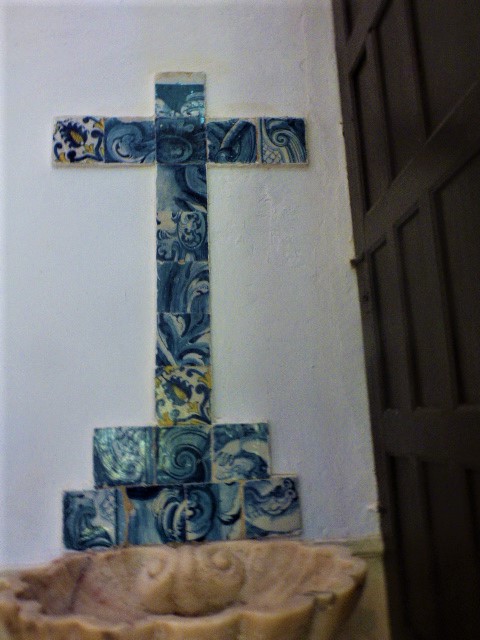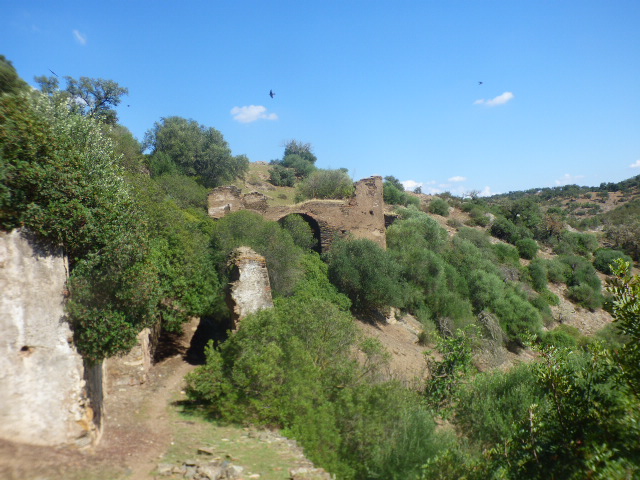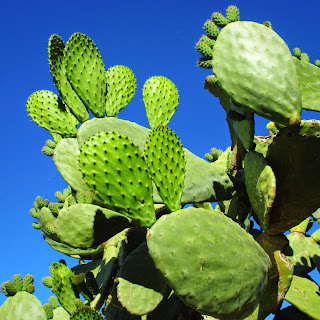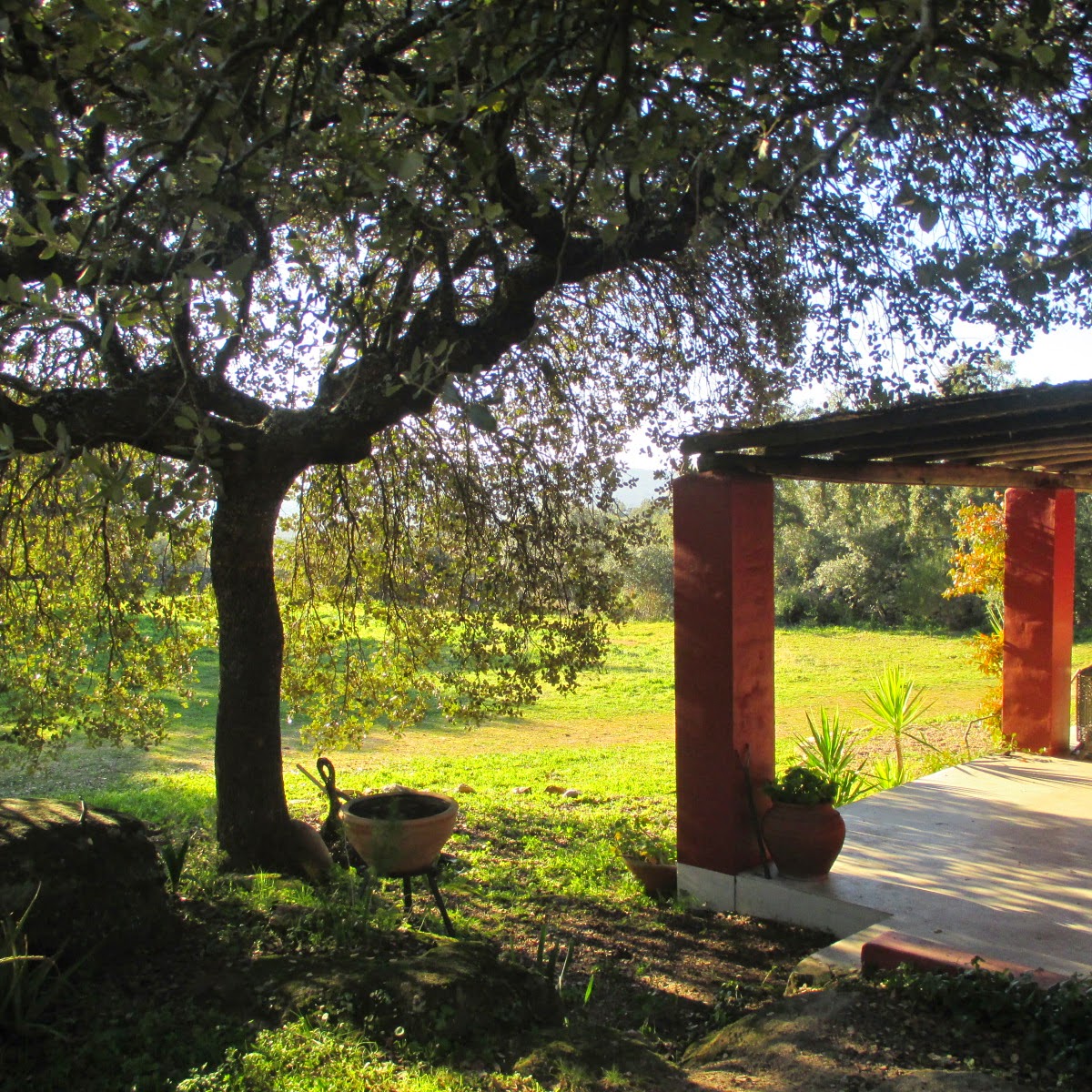It's not far to Olivenza from Finca al-manzil but it's a journey into a very different Extremadura. From the dramatic crags and dense woods of our sierra surrounded by small fincas filled with vines, fig and olive trees to vast sweeping areas devoted to vines producing the rich wines of the Tierra de Barra near the Guardiana river and endless dehesa with herds of Iberic pigs and cattle roaming freely in thousands of hectares, remote landscapes, seemingly untouched by time. Our destination was a mysterious and long abandoned Franciscan convent with origins in the XV century.

What a charming town, wide streets lined with trees and gleaming white town houses, all harmonious and pleasing to the eye. Its appearance reflects the early neo-classical period originating in Portugal after the massive reconstruction work carried out in Lisbon because of the earthquake and fire of 1775. Under the guidance of the Prime Minister of D. José I, the Marquis of Pombal, the rhythmic repetition of windows, set in sober and unadorned marble frames, and the absence of additions or decorations in any other part of the facade define this
Pombaline style of architecture.
The ancient 13th century town within the walls of the castle is a beautiful example of the military architecture of the time. It has a trapezoidal shape with a central courtyard with three cubic towers at the corners, in addition to the Torre del Homenaje from the time of the Portuguese king, D. Afonso IV 1291 – 1357, son of D. Dinis.
The Torre del Homenaje at 37 m high is the highest of the fortress towers on the Spanish-Portuguese border. Built in masonry reinforced by stone ashlars at the corners, it has 24 arrow slits that illuminate its interior. At the top of its four faces, you can still see the remains of the primitive machicolations that defended its flank, these are projecting structures supported by a row of corbels with openings in the floor through which stones and boiling liquids could be dropped on attackers. At the foot of the barbican, a moat was dug, ordered by D. João II in 1488, completely surrounding the fortress as there was little trust that the Spanish would not try to recapture the town. Also notable within the inner walls are the church of Santa Maria del Castillo, built on the site of the first Olivenza church, dating from the 13th century, this church was built between 1584 and 1627. The barracks are from the 18th century with their own bakery, the tall chimneys a relic of when it was providing bread for thousands of soldiers.On an attractive street with outdoor terraces of cafés and restaurants, just through one of the gates to the ancient town is the jewel of Olivenza, the church of Maria Magdalena . It was started in 1510 under the reign of Portuguese king Don Manuel I. in the Manueline style, which stems from late Gothic and is notable for its decorative and naturalistic character with marine elements referring to Portuguese dominance of the seas and discovery of sea routes to formerly unknown regions in Africa and Asia in the 15th and 16th century.
and the main door, with added decoration, attributed to Nicolas de Chanterenne a French sculptor who produced other important works in Portugal, such as the door of the Hieronymites Monastery in Lisbon or a marble altarpiece in the Pena Palace in Sintra, as well as other works in the Alentejo and Extremadura.
After this fascinating and enjoyable vistit to Olivenza we were on our way to the convent with only a very vague description of how to find it despite researching its history.
A shepherd discovered a statue of the virgin hidden in a cave, the much repeated format for the discovery of many effigies of the virgin mary throughout Spain. The legend says he took it home to Alconchel only to find it missing the next day, it was back in the cave in the middle of a remote, wild region. The word soon spread, and the cave became a place of pilgrimage and apparent miracles. The lord who owned the land paid for a small ermita to be built at the cave. In the XVI it was adopted by the newly formed order of Franciscan brothers who had split from the main order under the influence of San Pedro de Alcantara who wanted the Franciscans to return to their original austerity, a life of poverty and the bare minimum to sustain life together with draconian rules of prayer and penance as opposed to the luxury and decadence of the Roman Catholic church in Spain during that time, enriched beyond imagining by the constant flow of conquistador gold and silver plundered from the new world. These brothers were known as the decalzados, barefooted. It is said that San Pedro visited the convent in its early days to preach and advise on the patterns of life lived in scrupulous abstinence in remote places lost in nature such as San Pedro's own convent between Caceres and Coria, the so-called smallest monastery in the world The Convento de la Concepción de El Palancar is in Pedroso de Acim. https://finca-al-manzil.blogspot.com/search?q=convento+palancar
The brothers tried to stay faithful to a life of frugality recommended by San Pedro but there were many frictions and factions within the Fransiscan order during the following centuries. Life in such a remote region with few resources became untenable for the new generations of friars. The monastery fell into dilapidation and ruin. The image of the virgin had long since been removed and is now in the church of Alconchel. What remains is a whisper of the monastic atmosphere, the situation is still romantically beautiful on the banks of a flowing stream with lush vegetation hiding the last walls, vaulted ceilings and the bell tower, under this construction is the original cave with signs of the simple ermita, some niches where holy statues would have been placed. The most intact structure is the 18th century aqueduct which spans the river, a last attempt at sustaining the life of the monastery. By the time of the Peninsular wars of the early 19th century which caused further destruction, there was very little construction left. A sad fate for a place build to encourage the devout brothers in their stringent vows and fervent prayers.
It would be a matter of opinion if it was worth a 26km detour there and back to see the barely recognizable ruins of an old convent. We found it fascinating to drive on the narrow camino through a perfect dehesa landscape, meeting herds of black Iberic pigs and cattle grazing under ancient holm oaks with glimpses of vast views between the hills. The site of the convent could hardly be more remote even nowadays but in former centuries it would be a long walk to any civilization and a hard life in the idyllic valley, the tranquillity is still stunning, perfect peace with just the sounds of birdsong and running water.
Coming from Alconchel with its magnificent Castillo de Miraflores (open at weekends)
take the Ex 314 road to Cheles. After 3.50km there is a large barn on a hill on the left, just after there are caminos to left and right, take the left one which has a barely legible sign for Jarales, continue on the track, going through 4 gates with cattle grids until reaching the convent on the left before crossing the river. The convent has a wire fence surrounding it but broken in many places. Caution is needed as the slope is steep and the slate slippery, the remaining masonry is precarious, be careful!






















































